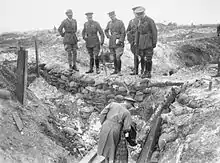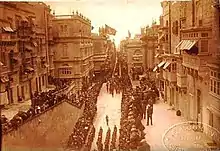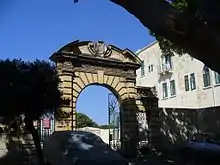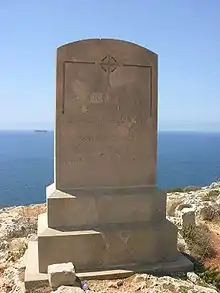Walter Norris Congreve
General Sir Walter Norris Congreve VC KCB MVO DL KStJ (20 November 1862 – 28 February 1927) was an English Army officer in the Second Boer War and the First World War, and Governor of Malta 1924–1927. He received the Victoria Cross, the highest and most prestigious award for gallantry in the face of the enemy that can be awarded to British and Commonwealth forces.
Sir Walter Norris Congreve | |
|---|---|
 | |
| Born | 20 November 1862 Chatham, Kent, |
| Died | 28 February 1927 (aged 64) Mtarfa Hospital, Malta |
| Buried | Buried at sea between Malta and the Island of Filfla |
| Allegiance | |
| Service/ | |
| Years of service | 1885–1924 |
| Rank | General |
| Unit | Rifle Brigade |
| Commands held | 6th Division XIII Corps VII Corps Egyptian Expeditionary Force Southern Command |
| Battles/wars | Second Boer War World War I |
| Awards | Victoria Cross Knight Commander of the Order of the Bath Member of the Royal Victorian Order |
| Relations | Major William La Touche Congreve VC (son) |
| Other work | Deputy Lieutenant of Staffordshire Governor of Malta |
Early life
Walter Norris Congreve was the son of William and Fanny E. Congreve of Castle Church, Stafford.[1] He was educated at Twyford School, Harrow School and Pembroke College, Oxford.[2]
Early military career
Congreve was commissioned a lieutenant in the Rifle Brigade on 7 February 1885 and promoted to captain on 6 December 1893.[3]
Second Boer War
The Second Boer War started in October 1899 with a Boer offensive into the British-held Natal and Cape Colony areas. Congreve arrived in South Africa and was posted as a brigade major in the Ladysmith relief force. He was present at the Battle of Colenso when British troops commanded by Sir Redvers Buller attempted to cross the Tugela River to relieve the besieged city of Ladysmith. The Boers repelled all British attempts to cross the river, and was forced to retreat in one of their biggest defeats of the war.
Action at Colenso
On 15 December 1899 at the Battle of Colenso, Captain Congreve with several others, tried to save the guns of the 14th and 66th Batteries, Royal Field Artillery, when the detachments serving the guns had all become casualties or been driven from their guns. Some of the horses and drivers were sheltering in a donga (gully) about 500 yards behind the guns and the intervening space was swept with shell and rifle fire. Captain Congreve, with two other officers (The Hon. Frederick Hugh Sherston Roberts and Harry Norton Schofield), and Corporal George Edward Nurse retrieved two of the guns. All four received the VC for this action. (F.S.H. Roberts was the son in one of the two other father and son pairs of VC winners.) Then, although wounded himself, seeing one of the officers fall, Congreve went out with Major William Babtie, RAMC, who also received the VC for this action, and brought in the wounded man. His citation read:
At Colenso on the 15th December, 1899, the detachments serving the guns of the 14th and 66th Batteries, Royal Field Artillery, had all been either killed, wounded, or driven from their guns by Infantry fire at close range, and the guns were deserted. About 500 yards behind the guns was a donga in which some of the few horses and drivers left alive were sheltered. The intervening space was swept with shell and rifle fire. Captain Congreve, Rifle Brigade, who was in the donga, assisted to hook a team into a limber, went out; and assisted to limber up a gun. Being wounded, he took shelter; but, seeing Lieutenant Roberts fall, badly wounded, he went out again and brought him in. Captain Congreve was shot through the leg, through the toe of his boot, grazed on the elbow and the shoulder, and his horse shot in three places.[4]
Later service in South Africa
Wounded, Congreve did not take part in the actual relief of Ladysmith in February 1900, but he was back in service later that year, and served as a staff officer. He served as adjutant in a newly established colonial mounted infantry regiment which, with the leave of Lord Roberts, was named after his chief of staff, "Kitcheners Horse". Kitcheners' Horse was employed, with distinction, in the operations undertaken by Lord Roberts in February 1900 for the relief of Kimberley and his advance on Bloemfontein and later Pretoria. Lord Kitchener took over the chief command of British forces in South Africa in November 1900, and appointed Congreve his personal secretary. He was promoted to major on 21 December 1901, and on the next day received a brevet promotion as lieutenant-colonel in recognition of services in South Africa.[5] Following the end of hostilities in early June 1902, he left Cape Town on board the SS Orotava together with Lord Kitchener,[6] and arrived at Southampton the next month.[7] He was mentioned in a despatch by Lord Kitchener in June 1902.[8]
World War I


After the Boer War Congreve held a series of command posts in Britain and Ireland. At the outbreak of World War I in August 1914, he was a Brigadier-General, commanding 18th Brigade who were on manoeuvres in Wales at the time. Although suffering from asthma, he deployed with them in the British Expeditionary Force (BEF) in France, taking part in the Battle of the Aisne.[9]
They were stationed near Neuve Chapelle when his men took part in the 1914 Christmas truce. In a letter written on Christmas Day itself, Brigadier-General Congreve wrote recalling how the Germans opposite his lines initiated by calling a truce earlier the same day, how one of his men got out over the parapet to meet in no man's land, and how officers and men exchanged cigars and cigarettes. Congreve admitted he was reluctant to personally witness the scene of the truce for fear he would be a prime target for German snipers.[10]
The Somme: Action at Delville Wood
Congreve commanded the 6th Division from May 1915 and then XIII Corps from November 1915.[11] As commander of XIII Corps, Congreve led the battles for Longueval and Delville Wood between 14 July and 3 September 1916. The rapid advance of his corps in the southern sector of the Somme offensive had brought about a situation where the allied front was set at a right angle – the left sector facing north and the right, facing east from Delville Wood. This meant that an advance on a wide front would result in the attacking forces diverging as they advanced.[12] In order to "straighten the line," General Sir Douglas Haig, Commander-in-Chief (C-in-C) of the BEF, had decided to exploit the advances which had been made by Congreve in the south by taking and holding the town of Longueval and Delville Wood. Being on fairly high ground and providing good spotting opportunities for artillery fire, an occupied Longueval would protect the right flank and allow the Allies to advance in the north and align their left with that of Congreve's XIII Corps on the right.[13] XIII Corps succeeded in securing Delville Wood, but it was one of the bloodiest confrontations of the Somme, with both sides incurring large casualties. During the war, Congreve lost a hand in action.
Later life

Congreve continued his war service becoming General Officer Commanding VII Corps in 1918.[14] Later Congreve rose to the rank of general and was knighted. He was General Officer Commanding the Egyptian Expeditionary Force between 1919 and 1923 and then Commander-in-Chief Southern Command between 1923 and 1924.[14]
From 1924 to 1927, he served as the governor of Malta,[14] where he died. At his request, he was buried at sea in the channel between the coast and Filfla Island; there is a small monument to him on the coast between Hamrija Tower and the prehistoric site of Mnajdra; the channel between Malta and Filfla is known as Congreve Channel (the official name is 'Il-Fliegu ta' Filfla').
One of the three school houses of St. Edward's College in Cottonera, Malta, a Catholic school for boys founded in 1929 is also named after Congreve. The other two being Campbell and Ducane, after General David Campbell GCB and Sir John Philip Du Cane, all former governor-generals of Malta.[15]
There is also a stone bearing his name above the gate to the "Scouts" HQ in Floriana, just outside the capital Valletta.
From 1903 to 1924, Congreve had a home in Shropshire at West Felton Grange. His service in the First World War is recorded, with that of his son William, in a Roll of Honour book in St Michael's Church at West Felton.[16]
Family
Congreve married at St Jude's Church, Kensington, on 18 May 1890, Cecilia Henrietta Dolores Blount La Touche.[17] Lady Congreve was a poet and author of "The Firewood Poem".[18]
They were the parents of Major William La Touche Congreve, VC – they are one of only three father and son pairs to win a VC. Their younger son Geoffrey Cecil Congreve was created a baronet, of Congreve in the County of Stafford, in July 1927 (see Congreve baronets).[19]
Victoria Cross
Congreve's Victoria Cross is on display at the Royal Green Jackets (Rifles) Museum, Winchester, England.
Citations
- Buchan, John (1992). The history of the South African forces in France (Litho reprint of 1920 ed.). London: Imperial War Museum & Battery Press. ISBN 0-901627-89-5.
- Prior, Robin and; Wilson, Trevor (2005). The Somme (1st ed.). New Haven: Yale University Press. ISBN 0-300-10694-7.
- David Harvey, Monuments to Courage, 1999
- The Register of the Victoria Cross (This England, 1997)
- Ian Uys, Victoria Crosses of the Anglo-Boer War, 2000
References
- 1871 Census. The National Archives. Public Record Office Ref. RG10/2819. 109 Page 7.
- Ian F. W. Beckett, ‘Congreve, Sir Walter Norris (1862–1927)’, Oxford Dictionary of National Biography, Oxford University Press, Sept 2004; online edn, May 2006, accessed 31 May 2009
- Hart′s Army list, 1903
- "No. 27160". The London Gazette. 2 February 1900. p. 689.
- "No. 27399". The London Gazette. 21 January 1902. p. 455.
- "The Army in South Africa - Troops returning home". The Times (36804). London. 26 June 1902. p. 10.
- "Lord Kitchener′s return". The Times (36819). London. 14 July 1902. p. 6.
- "No. 27459". The London Gazette. 29 July 1902. p. 4835.
- Francis, Peter (2013). Shropshire War Memorials, Sites of Remembrance. YouCaxton Publications. p. 167. ISBN 978-1-909644-11-3.
- "General's letter from trenches". Shropshire Star. 5 December 2014. p. 12.The letter describing the events had been published after discovery by Staffordshire County Council's archive service.
- Army Commands Archived 5 July 2015 at the Wayback Machine
- Prior & Wilson p.141
- Buchan p. 57
- Liddell Hart Centre for Military Archives
- "About us". St. Edward's College. Retrieved 4 December 2014.
- Francis, Peter (2013). Shropshire War Memorials, Sites of Remembrance. YouCaxton Publications. p. 165. ISBN 978-1-909644-11-3.
- The Peerage.com, p. 6825
- Lady Congreve's Garden of Verse, The New York Times, 13 August 1922
- "No. 33292". The London Gazette. 8 July 1927. p. 4406.
External links
| Wikimedia Commons has media related to Walter Norris Congreve. |
| Military offices | ||
|---|---|---|
| Preceded by John Keir |
General Officer Commanding the 6th Division May 1915 – November 1915 |
Succeeded by Charles Ross |
| Preceded by New Post |
GOC XIII Corps November 1915 – January 1918 |
Succeeded by Post Disbanded |
| Preceded by Thomas Snow |
GOC VII Corps January 1918 – April 1918 |
Succeeded by Post Disbanded |
| Preceded by Viscount Allenby |
General Officer Commanding the British Troops in Egypt and the Egyptian Expeditionary Force 1919–1923 |
Succeeded by Sir Richard Haking |
| Preceded by Sir Christopher Nicholl |
Colonel-Commandant of the 1st Battalion, Rifle Brigade (Prince Consort's Own) 1921–1927 |
Succeeded by Sir Victor Couper |
| Preceded by Sir George Harper |
GOC-in-C Southern Command 1923–1924 |
Succeeded by Sir Alexander Godley |
| Government offices | ||
| Preceded by The Lord Plumer |
Governor of Malta 1924–1927 |
Succeeded by Sir John Du Cane |
